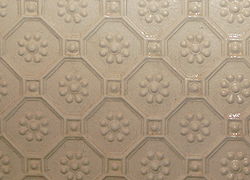

Lincrusta is a deeply embossed wallcovering, invented by Frederick Walton. Walton was already known for patenting linoleum floor covering in 1860. Lincrusta was launched in 1877 and was used in a host of applications from royal homes to railway carriages. Many examples over a hundred years old can still be found throughout the world.
Commonly found in Victorian properties and restoration projects, Lincrusta is also frequently used in commercial projects such as hotel foyers, bars, restaurants and casinos. Notable installations included six staterooms on the Titanic, and in the United States the White House, the Winchester Mystery House and Roseland Cottage in Woodstock, Connecticut, where it has been completely restored and is on view to the public.
History
Lincrusta was originally manufactured in Sunbury-on-Thames until 1918 when the manufacturing was moved to Darwen, Lancashire. The first production of Lincrusta in the United States was in 1883 in Stamford, Connecticut. There were also factories built in 1880 at Pierrefitte, France, and by 1889 in Hannover, Germany, Italy, and by 1898 in Milan Linoleum Compani Milan
Lincrusta is now produced in Morecambe, Lancashire using traditional methods. Heritage Wallcoverings Ltd acquired the Lincrusta operating assets in July 2014.
Production and characteristics
Lincrusta is made from a paste of gelled linseed oil and wood flour spread onto a paper base. It is then rolled between steel rollers, one of which has a pattern embossed upon it. The linseed gel continues to dry for many years, so the surface gets harder over time.
Both oil-based and water-based paints can be applied to Lincrusta; therefore, it can provide a base for effects from simple colour washes or marbling, scumbling, and glazing, to more elaborate gilding and vert de mer treatments.
References
- Yarwood, Doreen (1990) "The Domestic Interior: Technology and the Home" pp. 902-948 In McNeil, Ian (editor) (1990) Encyclopedia of the History of Technology Routledge, London, page 905, ISBN 0-415-01306-2
- ^ Bush, Akiko (2010) "An Introduction to Modern Textiles: The Wrong Impression" Dwelling 10(5): pp. 120-126, page 122
- "Gallery".
- "Our History".
- ^ Campbell, Gordon (editor) (2006) "Lincrusta" The Grove Encyclopedia of Decorative Arts volume 1, Oxford University Press, New York, page 41, ISBN 0-19-518948-5
Further reading
- Brazil, Helena (2018). Lincrusta-Walton 1877-1887: The Development, Design and Character of Lincrusta-Walton (Masters). University of Lincoln.
- Parsons, Ralph (1997) From Floor to Ceiling: How One Man's Inventions Brought Fame to Staines and Sunbury Spelthorne Museum, Staines, England, ISBN 0-9530265-0-7